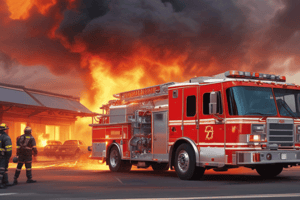Podcast
Questions and Answers
What is the primary consideration for notifying TFS Fire Investigations between 0700HRS and 2300HRS?
What is the primary consideration for notifying TFS Fire Investigations between 0700HRS and 2300HRS?
- The time of day the incident occurred
- The dollar value of damage caused
- The severity of the incident (correct)
- The type of occupancy involved
Which of the following incidents would require notification of TFS Fire Investigations?
Which of the following incidents would require notification of TFS Fire Investigations?
- A fire that is deemed accidental
- A fire that results in a fatality (correct)
- A small kitchen fire that was quickly extinguished
- A fire that only causes minor damage to a residential property
What happens to incidents that occur between 2300HRS and 0700HRS?
What happens to incidents that occur between 2300HRS and 0700HRS?
- They are only notified if a fatality occurs
- They are investigated immediately
- They are only notified if a serious injury occurs
- They are deferred until the next dayshift (correct)
Who can request notification of TFS Fire Investigations at any time?
Who can request notification of TFS Fire Investigations at any time?
What is the purpose of the Chief Officer's attempt to determine if a patient has been admitted to the hospital?
What is the purpose of the Chief Officer's attempt to determine if a patient has been admitted to the hospital?
Which of the following is NOT a criterion for notification of TFS Fire Investigations?
Which of the following is NOT a criterion for notification of TFS Fire Investigations?
What is considered a 'large loss fire'?
What is considered a 'large loss fire'?
What type of occupancies are considered 'vulnerable'?
What type of occupancies are considered 'vulnerable'?
What should Chief Officers do if they are unable to confirm patient status?
What should Chief Officers do if they are unable to confirm patient status?
What type of fire is deliberately set with the intent to cause a fire?
What type of fire is deliberately set with the intent to cause a fire?
Who is responsible for notifying the TFS Fire Investigation section in the event of a suspected incendiary fire?
Who is responsible for notifying the TFS Fire Investigation section in the event of a suspected incendiary fire?
What should be done to preserve the scene of an incendiary fire?
What should be done to preserve the scene of an incendiary fire?
When should Incident Commanders request assistance from TFS Fire Prevention Inspectors?
When should Incident Commanders request assistance from TFS Fire Prevention Inspectors?
Who should be notified after hours in the event of an extreme high risk situation?
Who should be notified after hours in the event of an extreme high risk situation?
Flashcards are hidden until you start studying
Study Notes
Guidelines for Fire Investigations
GUIDELINE PART 1 – NOTIFICATION CRITERIA (0700HRS to 2300HRS)
- Fires, explosions, or carbon monoxide poisonings resulting in a fatality
- Fires, explosions, or carbon monoxide poisonings resulting in a person being transported to hospital
- Suspected arsons
- Explosions, where the explosion is the primary event
- Fires or explosions in vulnerable occupancies (retirement homes, care, and treatment occupancies)
- Large loss fires or explosions (twice the current average residential value)
- Fires or explosions resulting in unusual smoke spread
- Fires or explosions involving circumstances that may result in widespread public concern
- Fires or explosions in multi-unit residential occupancies where fire spread beyond the unit of origin
- Fires or explosions with suspected fire code violations
- Fires or explosions involving clandestine drug operations or marijuana grow operations
- Fires or explosions at shelter housing and support hotels and shelters
- Any request from the Fire Chief, Deputy Fire Chief, On-call Senior Officer, or Division Chief, Fire Investigations
GUIDELINE PART 2 – NOTIFICATION CRITERIA (2300HRS to 0700HRS)
- Fires, explosions, or carbon monoxide poisonings resulting in a fatality
- Fires, explosions, or carbon monoxide poisonings resulting in a serious injury requiring a person(s) to be admitted to a hospital
- Explosions, where the explosion is the primary event
- Any request from the Fire Chief, a Deputy Chief, the On-call Senior Officer, or the Division Chief, Fire Investigations
- After 2300hrs, Chief Officers should make one (1) attempt to determine if the patient has been admitted to the hospital
GUIDELINE PART 3 – CAUSE DETERMINATION
- Incendiary Cause Determination:
- An Incendiary Fire is a fire that is deliberately set with the intent to cause the fire to occur in an area where fire should not be
- Incident Commander responsibilities:
- Notifying the TFS Fire Investigation section and requesting a Fire Investigator
- Limiting overhaul to preserve the scene
- Securing the scene and preservation of any evidence
- Ensuring notification of Toronto Police Service for scene and evidence protection
- Ensuring statements from the initial suppression team(s) are completed
GUIDELINE PART 4 – FIRE PREVENTION ASSISTANCE
- Incident Commanders shall request TFS Fire Prevention Inspectors assistance for:
- Situations requiring an Order to Close
- Situations considered Immediate Threat to Life (ITL) under Section 15 of the Fire Protection and Prevention Act (FPPA)
- After hours, TFS Communications Centre are to be notified that an extreme high-risk situation has been identified
- The on-call Senior Officer will need to be notified
- If necessary, the on-call Senior Officer may notify the standby Fire Investigator and the Deputy Chief of CRR
Studying That Suits You
Use AI to generate personalized quizzes and flashcards to suit your learning preferences.




